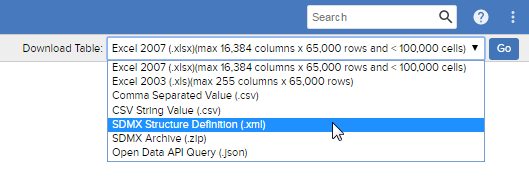Branding SDMX Downloads
SuperWEB2 users can download data from Table View in a variety of formats, including SDMX (Statistical Data and Metadata eXchange) Version 2.0:

The two available SDMX options are:
- An archive (.zip) file containing the SDMX data set (.xml) and the SDMX structure definition (.xml).
- SDMX structure definition (.xml).
Unlike downloads to Excel and CSV formats, which save wafers, SDMX downloads save cubes.
If you use the Job Queue Manager, you also need to configure SDMX settings in the Job Queue Manager as well as in SuperWEB2. For more information, see Job Queue Manager.
Configure SDMX Branding
There are a number of parameters you can configure in <tomcat_home>\webapps\webapi\WEB-INF\web.xml. These can be found in the following section:
<!-- SDMX configuration -->
<context-param>
<description>SDMX agency Id </description>
<param-name>AGENCY_ID</param-name>
<param-value>AGENCY_ID</param-value>
</context-param>
<context-param>
<description>SDMX agency name </description>
<param-name>AGENCY_NAME</param-name>
<param-value>AGENCY_NAME</param-value>
</context-param>
<context-param>
<description>SDMX user generated structure agency id</description>
<param-name>USER_GENERATED_STRUCTURE_AGENCY_ID</param-name>
<param-value>USER_GENERATED_STRUCTURE_AGENCY_ID</param-value>
</context-param>
<context-param>
<description>SDMX relative standard error id</description>
<param-name>RSE_CONCEPT_ID</param-name>
<param-value>RSE</param-value>
</context-param>
The parameters are as follows:
| Parameter | Description | Valid Characters |
|---|---|---|
AGENCY_ID | The SDMX agency ID. This value will be used in the SDMX The Agency ID is also written to the codelists in the SDMX structure definition file. | A-Z, a-z, 0-9, -, _, : and '.' |
AGENCY_NAME | The SDMX agency name. The Agency ID and Agency Name are written to the sender field in the headers of the SDMX structure definition file and the SDMX data file. | A-Z, a-z, *, @, 0-9, _, -and $ |
USER_GENERATED_STRUCTURE_AGENCY_ID | The user generated agency ID. This is written to the Agency ID field of the KeyFamilies section of the SDMX structure definition file. | A-Z, a-z, *, @, 0-9, _, -and $ |
RSE_CONCEPT_ID | The Relative Standard Error ID. | A-Z, a-z, *, @, 0-9, _, -and $ |
You will need to restart Tomcat or the SuperWEB2 service to apply any changes you make to web.xml.
Scaling Descriptions and Other Text Strings Used in SDMX Downloads
There are a number of text strings used in SDMX downloads that you can modify. These are defined in the database_labels.properties configuration file (located in <tomcat_home>\webapps\webapi\WEB-INF\classes).
There may be multiple copies of this file, with names like database_labels_en.properties, and database_labels_de.properties. These define the text for the different user interface languages, so if you want to make changes, you will need to apply these to multiple versions of the file, translated for each user interface language in use on your deployment. See Multilingual and Localisation Support for more information about localisation and how SuperWEB2 uses the properties files.
The following strings are available to be customised:
sdmx-codelist-measure = Measures
sdmx-codelist-unitMeasure = Unit of Measure
sdmx-codelist-unitMeasure-number = Number
sdmx-scaleDescriptions = Unit Multiplier
sdmx-scaleDescriptions-0 = Units
sdmx-scaleDescriptions-1 = Tens
sdmx-scaleDescriptions-2 = Hundreds
sdmx-scaleDescriptions-3 = Thousands
sdmx-scaleDescriptions-default = 10^%1$d Units
sdmx-codelist-aggregationLevel = Aggregation Level
sdmx-codelist-measureType = Measure Type
sdmx-codelist-measureType-count = Count
sdmx-codelist-measureType-sum = Sum
sdmx-codelist-measureType-mean = Mean
sdmx-codelist-measureType-median = Median
sdmx-codelist-concept-measureDimension = Measure dimension variables
sdmx-concept-unitMeasure = Unit in which the data values are measured
sdmx-concept-unitMultiplier = Exponent in base 10 .....
sdmx-concept-aggregationLevel = Record type used for aggregation
sdmx-concept-measureType = Method used to aggregate measures
sdmx-concept-observationValue = Observation value
sdmx-concept-observationValue-desc = The value, at a particular period, of a particular variable.
sdmx-concept-time = Time
sdmx-rse-name = Relative standard error
sdmx-rse-description = SDMX relative standard error descriptionThe sdmx-scaleDescriptions settings are used in the SDMX file when the dataset has scaled summation options. These strings can use the format described here: http://docs.oracle.com/javase/7/docs/api/java/util/Formatter.html
For example, the value %1 is the actual unit scale, as a power of ten (so units would be 1 and hundreds would be 2).
If you have multilingual datasets, and you are using Metadata Server, then the descriptions will be read from the keyword table in the external metadata database instead of the database_labels.properties configuration file. You will need to add the appropriate properties to the keyword table in your external metadata database.
If a particular label is not defined in the keyword table for the currently selected dataset language, then SuperWEB2 will check for a database_labels.properties file that matches the current dataset language. If a properties file exists for this language, then SuperWEB2 will fall back to this and use the definition from the file instead.
Survey Date
You can also set the survey date for the dataset. The survey date will be output to the <Time> element in the SDMX download. For example:
dataset.xml
<Series>
...
<Obs>
<Time>2010-03-05</Time>
...
</Obs>
</Series>To configure the survey date, use the following command in SuperADMIN:
cfg db <dataset_id> superweb2.surveyDate set <date>Where:
<dataset_id>is the ID of the dataset you want this date to apply to.<date>is the date in ISO-8601 format: YYYY-MM-DD
For example, the following command sets the survey date for the Retail Banking dataset:
cfg db bank superweb2.surveyDate set "2010-03-05"